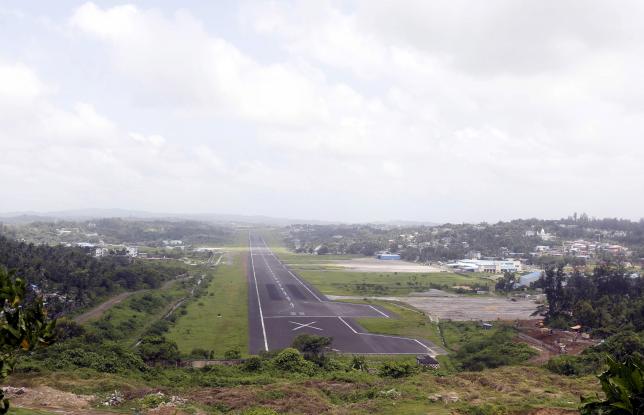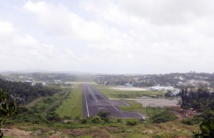Having conducted exercises in the waters of the disputed South China Sea, four Indian warships have cruised into the harbour in one of the Nicobar Islands.
The arrival of the warships symbolises how an island chain, which was better known for its honeymoon destination for its beaches and scuba diving experiences have now become a strategic turning point to countering the growing Chinese presence in the Indian ocean.
Indian defence officials have outlined plans that will dramatically see this stretch of beach and sand into a modern military base featuring strategic listening devices and backed up by capabilities from the army, navy and air force.
Although earlier plans on modernising the islands have faltered but under the new administration, officials feel that, a fresh impetus of completing defence projects that will help India reassert its traditional dominance in the Indian Ocean.
Officials agree that the strategic location of the chain of islands is of great importance as it will allow Indian defence forces to observe Chinese naval movements. The islands are located closer to Indonesia and Myanmar than to the Indian mainland. Interestingly, thanks to its southern-most tip, naval movements can be easily observed, since it is faces the gateway to the Indian Ocean. This passage is also heavily used by the Chinese to transport three quarters of their crude oil.
"The world's busiest shipping lanes are just to the south," said Lieutenant Governor A. K. Singh, a former military commander. "For too long we have had a fortress mentality about the islands, that they had to be defended. The time has come for us to start looking at these very strategically placed islands as a springboard for India."
Ever since 1962, wherein a border disagreement led to war, India has had a wary relationship with China. One of its current concerns is the lurking of Chinese submarines in Indian waters.
Naturally, the Chinese Foreign Minister denied and rejected, just as does when it is accused of hacking US military networks, the very notion that Chinese naval forays were behind any rise in Indian deployments. In fact, the Chinese Defense Ministry said, it’s army cooperates with India throughout the year.
"This is an added positive factor for regional peace and stability," the Defense Ministry said in a statement.
Regardless of what comes out of the Chinese Defence Ministry, As per Indian Defence Officials, India has started work on elongating airstrips located in the island chains to allow for landing and take-off of long range surveillance aircrafts.
The newly acquired P8i surveillance planes, which have anti-submarine capabilities, have already begun their sorties from Port Blair. Naval officials with knowledge of the plans, disclosed that once the old runways are elongated to 6,000 feet, airplanes could then make use of them from Campbell Bay as well.
"Of all the plans, and some are grand, upgrading Campbell is the critical one. You can watch a lot of stuff from there," said a naval source.
One notable roadblock was the erection of a radar station on Narcondum Island which local environmentalists had so far blocked since it would endanger a rare species of hornbill. However, the current Indian administration has given the go-ahead for the installation.
As per Jeff Smith, the author of "Cold Peace: China-India Rivalry in the 21st Century", India is now finally realising the "strategic goldmine" that is this chain of islands.
"I get the impression that growing concern over the pace of Chinese activity in the Indian Ocean increases the likelihood India will begin to take the Andamans more seriously," said Smith.
References:
http://www.reuters.com/article/2015/07/14/us-india-andamans-military-idUSKCN0PO2N120150714
The arrival of the warships symbolises how an island chain, which was better known for its honeymoon destination for its beaches and scuba diving experiences have now become a strategic turning point to countering the growing Chinese presence in the Indian ocean.
Indian defence officials have outlined plans that will dramatically see this stretch of beach and sand into a modern military base featuring strategic listening devices and backed up by capabilities from the army, navy and air force.
Although earlier plans on modernising the islands have faltered but under the new administration, officials feel that, a fresh impetus of completing defence projects that will help India reassert its traditional dominance in the Indian Ocean.
Officials agree that the strategic location of the chain of islands is of great importance as it will allow Indian defence forces to observe Chinese naval movements. The islands are located closer to Indonesia and Myanmar than to the Indian mainland. Interestingly, thanks to its southern-most tip, naval movements can be easily observed, since it is faces the gateway to the Indian Ocean. This passage is also heavily used by the Chinese to transport three quarters of their crude oil.
"The world's busiest shipping lanes are just to the south," said Lieutenant Governor A. K. Singh, a former military commander. "For too long we have had a fortress mentality about the islands, that they had to be defended. The time has come for us to start looking at these very strategically placed islands as a springboard for India."
Ever since 1962, wherein a border disagreement led to war, India has had a wary relationship with China. One of its current concerns is the lurking of Chinese submarines in Indian waters.
Naturally, the Chinese Foreign Minister denied and rejected, just as does when it is accused of hacking US military networks, the very notion that Chinese naval forays were behind any rise in Indian deployments. In fact, the Chinese Defense Ministry said, it’s army cooperates with India throughout the year.
"This is an added positive factor for regional peace and stability," the Defense Ministry said in a statement.
Regardless of what comes out of the Chinese Defence Ministry, As per Indian Defence Officials, India has started work on elongating airstrips located in the island chains to allow for landing and take-off of long range surveillance aircrafts.
The newly acquired P8i surveillance planes, which have anti-submarine capabilities, have already begun their sorties from Port Blair. Naval officials with knowledge of the plans, disclosed that once the old runways are elongated to 6,000 feet, airplanes could then make use of them from Campbell Bay as well.
"Of all the plans, and some are grand, upgrading Campbell is the critical one. You can watch a lot of stuff from there," said a naval source.
One notable roadblock was the erection of a radar station on Narcondum Island which local environmentalists had so far blocked since it would endanger a rare species of hornbill. However, the current Indian administration has given the go-ahead for the installation.
As per Jeff Smith, the author of "Cold Peace: China-India Rivalry in the 21st Century", India is now finally realising the "strategic goldmine" that is this chain of islands.
"I get the impression that growing concern over the pace of Chinese activity in the Indian Ocean increases the likelihood India will begin to take the Andamans more seriously," said Smith.
References:
http://www.reuters.com/article/2015/07/14/us-india-andamans-military-idUSKCN0PO2N120150714



















